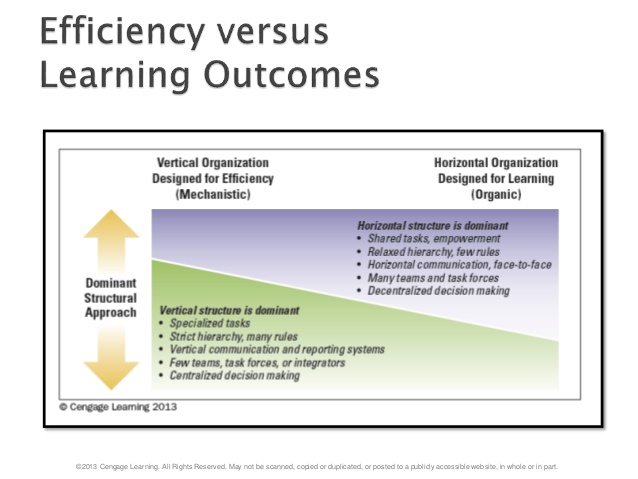Vertical Linkages
Structural Devices for Vertical Information Sharing
Organization designOpens in new window should facilitate the communication among employees and departments that is necessary to accomplish the organization’s overall task. Managers create information linkages to facilitate communication and coordination among organizational elements.
Vertical linkages are used to coordinate activities between the top and bottom of an organization and are designed primarily for control of the organization.
Employees at lower levels should carry out activities and accomplishments at the lower levels. OrganizationsOpens in new window may use any of a variety of structural devices to achieve vertical linkage. These devices include:
- Hierarchical referral,
- Rules and plans, and
- Formal management information systems.
 Figure X-3 The Relationship of Organization Design to Efficiency Versus Learning Outcomes | Credit — Slide Share Opens in new window
Figure X-3 The Relationship of Organization Design to Efficiency Versus Learning Outcomes | Credit — Slide Share Opens in new window
|
- Hierarchical Referral
The first vertical device is hierarchy, or chain of command, which is illustrated by the vertical lines in Figure X-3. If a problem arises that employees don’t know how to solve, it can be referred up to the next level in the hierarchy. When the problem is solved, the answer is passed back down to lower levels. The lines of the organization chart act as communication channels.
- Rules and Plans
The next linkage device is the use of rules and plans. To the extent that problems and decisions are repetitious, a rule or procedure can be established so employees know how to respond without communicating directly with their manager.
Rules and procedures provide a standard information source enabling employees to be coordinated without actually communicating about every task.
At PepsiCo’s GemesaOpens in new window cookie business in Mexico, for example, managers carefully brief production workers on goals, processes, and procedures so that employees themselves do most of the work of keeping the production process running smoothly, enabling the plants to operate with fewer managers.
Plans also provide standing information for employees. The most widely used plan is the budget. With carefully designed and communicated budget plans, employees at lower levels can be left on their own to perform activities within their resource allotment.
- Vertical Information Systems
A vertical information system is another strategy for increasing vertical information capacity.
Vertical information systems include the periodic reports, written information, and computer-based communications distributed to managers.
Information systems make communication up and down the hierarchy more efficient.
In today’s world of corporate financial scandals and ethical concerns, many top managers are considering strengthening their organization’s linkages for vertical information and control. The other major issue in organizing is to provide adequate horizontal linkages for coordination and collaboration.
The series:
- Research data for this work have been adapted from the manual:
- Organization Theory & Design By Richard L. Daft

